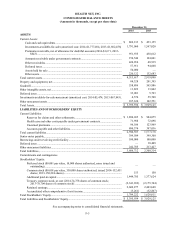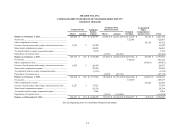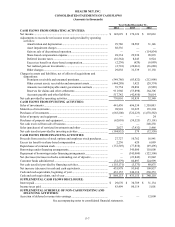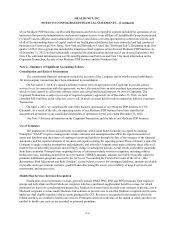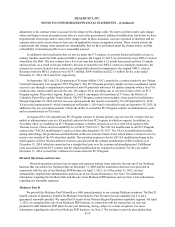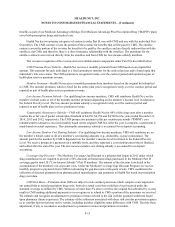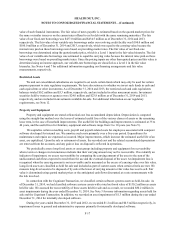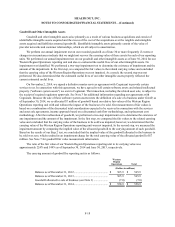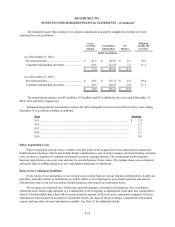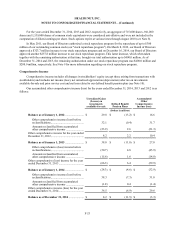Health Net 2014 Annual Report Download - page 122
Download and view the complete annual report
Please find page 122 of the 2014 Health Net annual report below. You can navigate through the pages in the report by either clicking on the pages listed below, or by using the keyword search tool below to find specific information within the annual report.HEALTH NET, INC.
NOTES TO CONSOLIDATED FINANCIAL STATEMENTS—(Continued)
F-12
We estimate the amount of the provision for health care service costs IBNR in accordance with GAAP and using
standard actuarial developmental methodologies based upon historical data including the period between the date
services are rendered and the date claims are received and paid, denied claim activity, expected medical cost inflation,
seasonality patterns and changes in membership, among other things. Our IBNR best estimate also includes a provision
for adverse deviation, which is an estimate for known environmental factors that are reasonably likely to affect the
required level of IBNR reserves. This provision for adverse deviation is intended to capture the potential adverse
development from known environmental factors such as our entry into new geographical markets, changes in our
geographic or product mix, the introduction of new customer populations, variation in benefit utilization, disease
outbreaks, changes in provider reimbursement, fluctuations in medical cost trend, variation in claim submission patterns
and variation in claims processing speed and payment patterns, changes in technology that provide faster access to
claims data or change the speed of adjudication and settlement of claims, variability in claim inventory levels, non-
standard claim development, and/or exceptional situations that require judgmental adjustments in setting the reserves
for claims. As part of our best estimate for IBNR, the provision for adverse deviation recorded at December 31, 2014
and 2013 was approximately $77.7 million and $53.4 million, respectively; the increase was primarily driven by growth
in our new products offered under the ACA.
We consistently apply our IBNR estimation methodology from period to period. Our IBNR best estimate is made
on an accrual basis and adjusted in future periods as required. Any adjustments to the prior period estimates are
included in the current period. As additional information becomes known to us, we adjust our assumptions accordingly
to change our estimate of IBNR. Therefore, if moderately adverse conditions do not occur, evidenced by more complete
claims information in the following period, then our prior period estimates will be revised downward, resulting in
favorable development. However, any favorable prior period reserve development would increase current period net
income only to the extent that the current period provision for adverse deviation is less than the benefit recognized from
the prior period favorable development. If moderately adverse conditions occur and are more acute than we estimated,
then our prior period estimates will be revised upward, resulting in unfavorable development, which would decrease
current period net income. For the year ended December 31, 2014, we had $14.6 million in net favorable reserve
developments related to prior years. This reserve development for the year ended December 31, 2014 consisted of $36.6
million in unfavorable prior year development primarily due to the existence of moderately adverse conditions and a
release of $51.2 million of the provision for adverse deviation held at December 31, 2013. We believe that the $36.6
million unfavorable development for the year ended December 31, 2014 was primarily due to unanticipated benefit
utilization in our commercial business arising from dates of service in the fourth quarter of 2013 as a result of an
uncertain environment related to the ACA. For the year ended December 31, 2013, we had $56.2 million in favorable
reserve developments related to prior years. We believe this favorable development was primarily due to the absence of
moderately adverse conditions. The reserve developments related to prior years for the years ended December 31, 2014
and 2013, when considered together with the provision for adverse deviation recorded as of December 31, 2014 and
2013, respectively, did not have a material impact on our operating results or financial condition.
The majority of the IBNR reserve balance held at the end of each year is associated with the most recent months'
incurred services because these are the services for which the fewest claims have been paid. The degree of uncertainty
in the estimates of incurred claims is greater for the most recent months' incurred services. Revised estimates for prior
periods are determined in each year based on the most recent updates of paid claims for prior periods. Estimates for
service costs incurred but not yet reported are subject to the impact of changes in the regulatory environment, economic
conditions, changes in claims trends, and numerous other factors. Given the inherent variability of such estimates, the
actual liability could differ materially from the amounts estimated.
We assess the profitability of contracts for providing health care services when operating results or forecasts
indicate probable future losses. Contracts are grouped in a manner consistent with the method of determining premium
rates. Losses are determined by comparing anticipated premiums to estimates for the total of health care related costs
less reinsurance recoveries, if any, and the cost of maintaining the contracts. Losses, if any, are recognized in the period
the loss is determined and are classified as Health Plan Services cost. As of December 31, 2014 and 2013, respectively,
we held no premium deficiency reserves.





